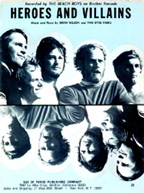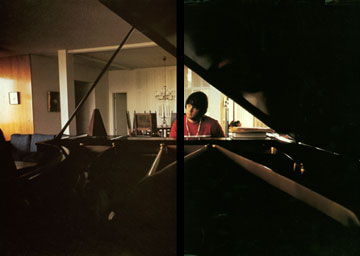|
Previous
Next
|
"Heroes
And Villains"
"Now in watching a drama
or reading a story we know, at least in the back of our minds,
that the situation is "in play." We have therefore
not the least objection to there being a "villain of the
piece" or other agency which upsets the initial status
quo. On the contrary, this is just what we expect to see,
and, at the end of the show, hero and villain alike are applauded.
For the hero is the hero just because of the villain. To put
it in another way, the convention of the stage or the proscenium
arch enables us to see that the deeds of the villain are grounds
for the heroism of the hero, and we recognize the necessity of
the relationship."~Alan Watts, The Two Hands Of God(pgs.32-33.)

"...life is problematic...so long as it seems that there
is a real choice between the opposites. True integrity is therefore
the recognition that it is simply impossible to take sides, except
in play or illusion. To take the side of one's own advantage
in the struggle to survive is not so much a wickedness as an
impossibility, for no being lives (i.e., survives) except
in relation to the whole community of beings."
~The Two Hands Of God(pgs.201-202.)
A dominant characteristic
of the religious psychedelic experience is what Alan Watts calls
awareness of polarity. "This
is the vivid realization that states, things, and events which
we ordinarily call opposite are interdependent, like back and
front or the poles of a magnet. By polar awareness one sees that
things which are explicitly different are implicitly one: self
and other, subject and object, left and right, male and female--and
then, a little more surprisingly, solid and space, figure and
background, pulse and interval, saints and sinners, and police
and criminals, ingroups and outgroups."-Does It Matter?,
published 1970, (pg.83.)
Heroes and villains, ingroups
and outgroups, self and other, organism and environment, they
all go together. "From the ecological and biophysical standpoints
every organism goes with its environment transactionally: the
one implies the other as buying implies selling and front implies
back and the positive pole implies the negative....The basic
point to be understood, then, is that it is simply impossible
to improve either oneself or the world by force. Because you
yourself are both the organism and its environment....Untold
psychic and physical energy is wasted in this ludicrous enterprise,
which, when seen to be absurd, is abandoned, releasing that energy
for tasks which can indeed be accomplished."-Does
It Matter?, (pgs.76-77.)
 "What, exactly, is polarity?
"What, exactly, is polarity?
It is something much more than simple duality or opposition.
For to say that opposites are polar is to say much more
than that they are far apart: it is to say that they are related
and joined--that they are the terms, ends, or extremities of
a single whole. Polar opposites are therefore inseparable
opposites, like the poles of the earth or of a magnet, or the
ends of a stick or the faces of a coin. Though what lies between
the poles is more substantial than the poles themselves--since
they are the abstract "terms" rather than the concrete
body--nevertheless man thinks in terms and therefore divides
in thought what is undivided in nature. To think is to categorize,
to sort experience into classes and intellectual pigeonholes.
It is thus that, from the standpoint of thought, the all-important
question is ever, "Is it this, or is it that?" Is the
experience inside, or is it outside? By answering such questions
we describe and explain the world; we make it explicit. But implicitly,
in nature herself, there are no classes. We drop these intellectual
nets and boxes upon the world as we weave the imaginary lines
of latitude and longitude upon the face of the earth and the,
likewise imaginary, firmament of the stars. It is thus the imaginary,
abstract, and conceptual character of these divisions which renders
them polar. The importance of a box for thought is that the inside
is different from the outside. But in nature the walls of a box
are what the inside and the outside have in common.
It is thus when anyone draws attention to the implicit unity
of polar opposites we feel something of a shock. For the foundations
of thought are shakes by the suspicion that experiences and values
which we had believed to be contrary and distinct are, after
all, aspects of the same thing...."~Alan Watts, The
Two Hands Of God, (pgs.49 & 50.)
 "...oneself," in the ordinary sense of one's
ego, doesn't exist. It seems to exist, in a way, in the
same sense that the equator exists as an abstraction. The ego
is not a psychological or physical organ, it's a social convention,
like the equator, like the clock or the calendar, or like the
dollar bill. These social conventions are abstractions which
we agree to treat as is if they did exist. We live in relation
to the external world in just exactly the same way that one end
of the stick exists in relation to the other end. The ends are
indeed different, but they're of the same stick.
"...oneself," in the ordinary sense of one's
ego, doesn't exist. It seems to exist, in a way, in the
same sense that the equator exists as an abstraction. The ego
is not a psychological or physical organ, it's a social convention,
like the equator, like the clock or the calendar, or like the
dollar bill. These social conventions are abstractions which
we agree to treat as is if they did exist. We live in relation
to the external world in just exactly the same way that one end
of the stick exists in relation to the other end. The ends are
indeed different, but they're of the same stick.
Likewise, there is a polar relationship between what you call
your "self" and what you call "other." You
couldn't experience your "self" unless you could experience
"other," nor could you experience "other"
unless you also had the experience of "self." We might
say that we feel that one's "self" and the "other"
are poles apart. Oddly, we use that phrase, "poles apart,"
to express extreme difference. But things that are "poles
apart" are poles of something, as of a magnet, or
a globe, and so are actually inseparable. What happens if you
saw the south pole off a magnet with a hacksaw? The new end,
opposite the original north pole, becomes the south pole,
and the piece that was chopped off develops its own north pole.
The poles are inseparable and generate each other."
~Alan Watts, Cloud-hidden, Whereabouts Unknown,
published 1974, (pg. 93.)
"Like Zen, the Tao is beyond
words, and any attempt to pigeonhole it is to miss the point....Yet
it has a symbol which is very instructive, the tai chi
symbol of yin-yang."
~Gary Gach, The Complete Idiot's Guide To Understanding
Buddhism,
published 2002, (pg. 63.)
"They go together....And
this of course is represented in this fundamental Chinese figure
of the yang, or positive principal, and the yin,
or the negative principal, like two fishes constantly circling
going round and round and round and round in the alternations
of life.
Now, the question is, "are these two fishes involved in
a fight? Is the white one eating up the black one and the black
one trying to eat up the white one?" If that is the situation...then
of course life is a fundamentally nothing but a grim contest.
If this one up here is the good fellow and this one is the bad
fellow...if this is order and this is chaos, then a fight goes
on between them and that's largely the way in which our technology
has interpreted man's situation against nature. This is man,
the white, the good fellow, this is nature the dark, the bad
fellow, and the white one has to eat him up. But what happens
if the white fish succeeds in eating up the dark fish? The white
fish disappears as well as the dark one, 'cause the white one
is only there in relation to the dark.
So then, if these two fishes, as it were, wake up...if
this one wakes up and this one wakes up, which is called "awakening"
in Buddhism, they realize they're one! In other words they go
together, they're inseparable from each other. And this realization
is that experience which is called in Zen satori, or in
Buddhism bodhi, awakening. This sudden dawning on our
consciousness that life is not really a contest to make yes triumph
over no, to make the positive triumph over the negative. The
two sides go together. And then one sees in this strange way
that underlying all that is negative in the world all, that is
in a way painful and evil there is a kind of a necessity to it.
It goes with the good. It is necessary for the good.
Disorder is necessary for the manifestation of order just as
you must have, say, a black background to show off a light figure
and then when one sees that--a profound transformation takes
place in one's altitude toward the world. That is to say...instead
of looking upon life as a contest it becomes a game. One doesn't
withdraw from it, one doesn't stop living, but one goes into
the game so that these revolving fishes are no longer trying
to eat each other but they're going around dancing having the
biggest fun in the world. So then, must we have fixed in our
minds the idea that all the forms and patterns in nature are
simply methods of attack or defense, that they're devices for
camouflage, that they're simply lures for sexual attraction or
other utilitarian purposes, or can we see in them a dance, a
joyous cosmology."-Alan Watts
 "The more extreme my position
is, the more it embraces my worst enemy's."
"The more extreme my position
is, the more it embraces my worst enemy's."
~Gary Gach, The Complete Idiot's Guide To Understanding
Buddhism,
published 2002, (pg. 63.)
""Rio Grande"
is a Cowboy song and an Indian song....It wasn't Indians
and Cowboys fighting..."-Brian Wilson
"Opposites and differences
have something between them, like the two faces of a coin; they
do not meet as total strangers. When this relativity of things
is seen very strongly, its appropriate affect is love rather
than hate and fear....It is fine for us to agree that we are
different from each other, provided we do not ignore the fact
that we agreed to differ. We did not differ to agree,
to create society by deliberate contract between originally independant
parties. Furthermore, even if there is to be a battle, there
must be a field of battle; when the contestants really notice
this they will have a war dance instead of war."
~Alan Watts, Psychotherapy East And West,
(pg. 44.)
|